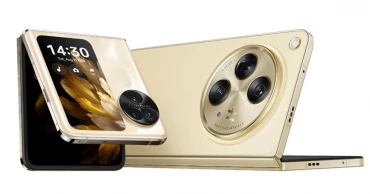Snapdragon 8 Gen 2 4nm
Xiaomi Redmi K70 Review: Mid-range phone with flagship features
On November 29th, 2023, Xiaomi unveiled three new devices, including the Redmi K70. This device appears as a worthy successor to the Redmi K60, boasting several enhancements over its predecessors. Xiaomi has managed to deliver notable improvements in K70 while keeping its price at a mid-range level. Let’s take a look at the key specs, pros, cons, and price of the Redmi K70.
Key Features of Xiaomi Redmi K70
Design
The Xiaomi Redmi K70 combines a sleek and lightweight design, weighing 209g and measuring 160.9 mm by 75 mm by 8.2 mm. The dual Nano-SIM capability enhances network flexibility, catering to diverse user needs. The subtle design changes include a modified photo module block, a distinct texture on the glass panel, and a reduced steel size relative to the display frame.
The plastic edging, while maintaining durability, reflects cost-saving measures. The device's thickness stands at 8.2mm, contributing to its ergonomic feel in hand. Although lacking weather-sealing for splash resistance, the Redmi K70 impresses with a manageable weight, compact dimensions, and a volumetric capacity of 98.95cm³, making it a practical and stylish choice for users seeking a balanced smartphone experience.
Read more: Most Hyped Smartphones Releasing in December 2023
Display
The Xiaomi Redmi K70 impresses with a visually stunning 6.67-inch OLED screen, boasting a 1440 by 3200 pixels resolution that ensures intricate details in visuals. With a 120Hz refresh rate, the display delivers seamless and fluid motion across various media, enhancing the overall user experience.
Notably, the screen achieves an industry-leading peak brightness of 4000 nits, setting a new standard for comfortable viewing even under bright sunlight. The incorporation of an AI algorithm elevates the display further by upscaling select apps and video games, ensuring crisp and vibrant visuals. The technology behind the screen includes OLED/AMOLED, offering vibrant colors.
With a pixel density of 526 ppi, the Redmi K70 ensures clarity and sharpness in image rendering. The support for HDR10 and HDR10+ technologies, along with Dolby Vision, enhances color depth and contrast for a lifelike visual experience. The inclusion of features like an always-on display and a touch sampling rate of 480Hz adds to the device's appeal, making the Redmi K70 a standout choice for those seeking a top-tier display in a smartphone.
Cameras
The Xiaomi Redmi K70 boasts an impressive camera setup, featuring a 50MP primary sensor with an f/1.6 aperture and 1/1.55-inch size for exceptional image quality. The main sensor is equipped with Optical Image Stabilization (OIS), ensuring steady videos and sharp photos even in dynamic conditions.
Read more: itel A70 Review: A standard entry-level phone
Complementing this, the 8MP ultrawide lens and 2MP macro sensor enhance versatility, enabling users to capture a wide range of scenes with detail and clarity.
The front camera sports a 16MP sensor, perfect for high-resolution selfies.
Noteworthy features include built-in optical image stabilization, continuous autofocus for video recording, and phase-detection autofocus for photos, ensuring sharp and clear shots.
With the main sensor, this device can shoot 8K footage at 24fps, 4K videos at 24/30/60fps, 1080p videos at 30/60/120/240/960fps, and 720p footage at 1920fps. It has a gyro-EIS feature.
The front camera is capable of capturing 1080p videos at 30/60fps with gyro-EIS.
The inclusion of slow-motion video recording, dual-tone LED flash, HDR mode, and manual exposure settings further elevate the camera capabilities, making the Redmi K70 a reliable choice for photography enthusiasts seeking diverse and high-quality imaging experiences.
Read more: Google Pixel 8 Pro Review: Is this the best Android phone of 2023?
Performance and Software
The Xiaomi Redmi K70 is powered by the Snapdragon 8 Gen 2 4nm processor, offering robust performance for games and applications, despite being one generation behind the latest Qualcomm chip. Its graphic section is equipped with GPU Adreno 740.
Paired with up to 16GB of LPDDR5X RAM, the device excels in handling resource-intensive tasks and ensures smooth multitasking.
With internal storage options reaching up to 1TB of UFS 4.0 storage, the Redmi K70 provides ample space for fast data transfers and extensive file storage.
Running on Android 14, the device introduces advanced privacy features, including clipboard warnings, location privacy options, and camera/microphone privacy controls. Additionally, users can enjoy theme customization, personalizing their devices according to their preferences.
The Redmi K70's hardware specifications, coupled with the latest Android version, promise a seamless and feature-rich experience for users, making it a compelling choice in the smartphone market.
Read more: realme GT5 Review: A gaming phone with high capability
Battery and Charger
The Xiaomi Redmi K70 is equipped with a non-removable Li-Po 5000 mAh battery, ensuring a reliable power source for extended usage. What sets it apart is its exceptional charging capability, supporting a blazing-fast 120W wired charging system.
With PD3.0 and QC3+ compatibility, the device boasts an advertised 100% charge in just 18 minutes. This impressive charging speed adds convenience to the user experience, addressing power needs swiftly and efficiently, making the Redmi K70 a compelling choice for those seeking a quick and reliable charging solution.
Pros and Cons of Xiaomi Redmi K70
Pros
- Sleek and lightweight design- Up to 16GB RAM, up to 1TB storage- Android 14 with privacy features- 120W wired charging- 8K video footage.
Read more: OPPO Find N3 Review: A New Standard for Foldable Smartphones
Cons
- Lack of weather-sealing- Plastic edging- Specific wide aperture details not provided
Price of Redmi K70
The Xiaomi Redmi K70 is priced at CNY 2499 in China, which translates to BDT 38786 in Bangladesh. The conversion rate between Chinese Yuan (CNY) and Bangladeshi Taka (BDT) is CNY 1 = BDT 15.52. So, if you're considering the cost in Bangladesh, it would be BDT 38786 based on the current exchange rate.
Summing Up
Redmi K70 with a well-balanced package with a sleek design, robust RAM, a powerful processor, and a smart display. The camera setup is also decent. One of the most remarkable features is 120W wired charging, promising a full charge in just 18 minutes. Its 8K video recording is also impressive. However, the device lacks weather-sealing and comes with plastic edging.
On the whole, Redmi K70 is a compelling choice for users seeking a feature-rich smartphone at a competitive price point. It won’t be overwhelming to say that Xiaomi Redmi K70 is a contender for the best mid-range smartphone of 2023.
Read more: vivo X100 Review: The Flagship Killer of 2023
2 years ago
OPPO Find N3 Review: A New Standard for Foldable Smartphones
The Find series from OPPO has been their premium flagship range since the brand’s inception. It brought top-of-the-line features that competed for the best of what Android has to offer. Back in 2021, the N series was introduced as OPPO’s first take on foldable and flip phones. Fast forward to 2023, OPPO released the Find N3 foldable smartphone on 19th October in China. The N3 brings some big and effective changes compared to the N2. Let’s find out what those are.
Key Specifications of OPPO Find N3
Design and Build Quality
The Find N3 doesn’t really reinvent the wheel. It looks similar to the existing range of foldables from the likes of Huawei and Samsung. There is a distinct round camera housing on the back with Hasselblad branding that gives it its distinguishing look.
Coming to the design specifics, the curves around the hinges have been sharpened. It might be due to the hinge mechanism used in the N3. Speaking of the hinge mechanism, it now does an excellent job of dissipating the crease at the middle of the inner display. It’s still possible to feel the crease by touch, but visually it is much less pronounced compared to the Mate X5 or the Z Fold5.
Read more: Top 10 Smartphones Coming to Bangladesh in November 2023
The front glass and aluminum frame are complemented by a choice of either a glass back or an eco-leather back. The dimension comes in at:
Glass Folded: 153.4 x 73.3 x 11.7 mmEco-leather Folded: 153.4 x 73.3 x 11.9 mmGlass Unfolded: 153.4 x 143.1 x 5.8 mm Eco-leather Unfolded: 153.4 x 143.1 x 6.0 mm
The weight comes in at 239 g for the eco-leather option and 245 g for the glass-back variant. The front is protected by OPPO’s own Ceramic Guard protection with the inner panel being a plastic one as usual. The choice of ports and buttons are carried over from the N2 which means the 3.5 mm headphone jack didn’t make the cut. The power button doubles as the fingerprint scanner similar to the N2.
Read more: Xiaomi Redmi Note 13 Pro Plus Review: Know the Pros and Cons
Another useful addition this time around has been the IPX4 splash resistance rating. Overall, the updated hinge mechanism massively improves the experience and alleviates the design experience of the device.
The Display
OPPO used the new state-of-the-art LTPO3 OLED panels for the N3. The cover screen is a 6.31-inch panel with 1116 x 2484 pixels with 431 ppi density. The panel supports 1.07B colors, Dolby Vision, 120Hz refresh rate, and 2800 nits of peak brightness in HBM.
On the other hand, the inner panel is a 7.82-inch Foldable LTPO3 OLED panel with 2268 x 2440 pixels resolution at 426 ppi. The panel supports 1.07B colors, Dolby Vision, 120Hz refresh rate, and 2800 nits of HBM. The screen-to-body ratio of the N3 comes in at 89.6%.
The best thing about the N3 display is the utilitarian design. The cover screen isn’t unnaturally tall like that of the Z Fold5. Rather it looks much like a standard smartphone. The inner screen is also 1:1 which gives it a square look. This display design enhances the usability all the while being a cutting edge panel.
Read more: vivo V29e 5G Review: Is this mid-range phone rightly priced?
Being an LTPO3 panel, the screen is everything one would expect from it. It has high contrast, great color, and amazing visibility under direct sunlight. And thanks to the new hinge mechanism, the inner crease also isn’t as distracting anymore.
2 years ago



